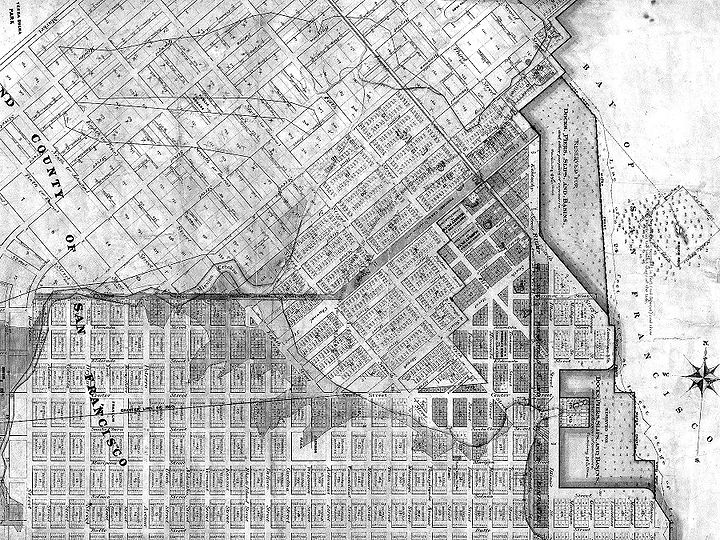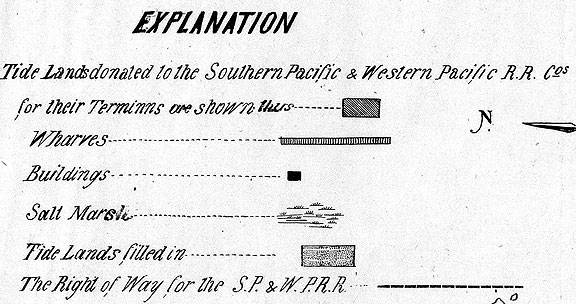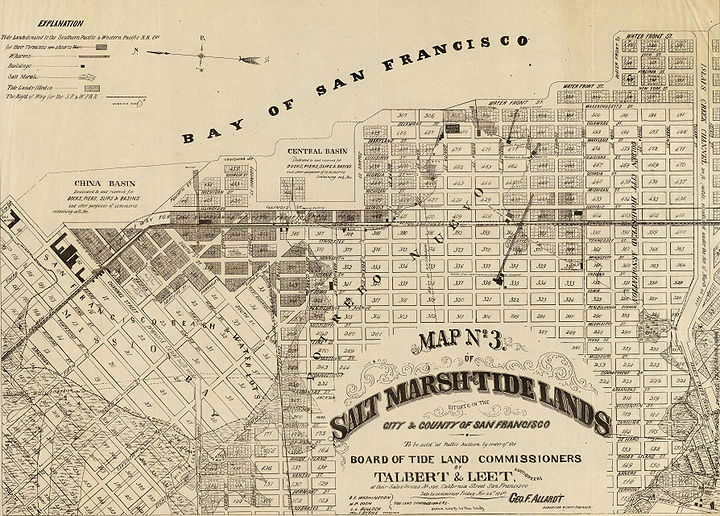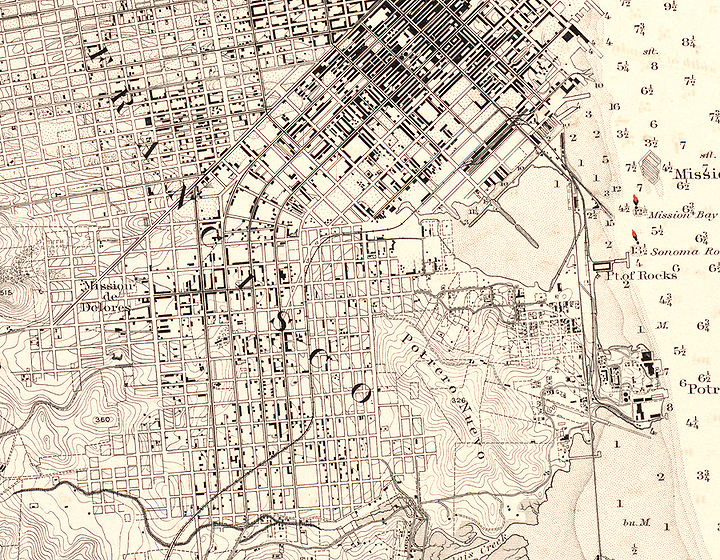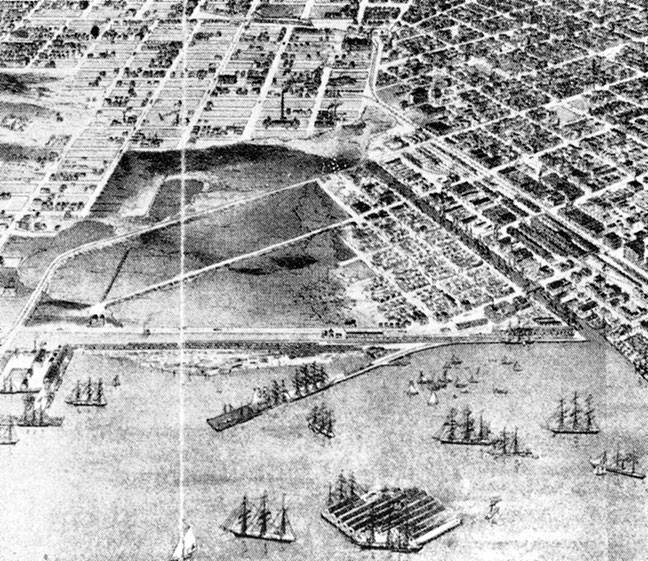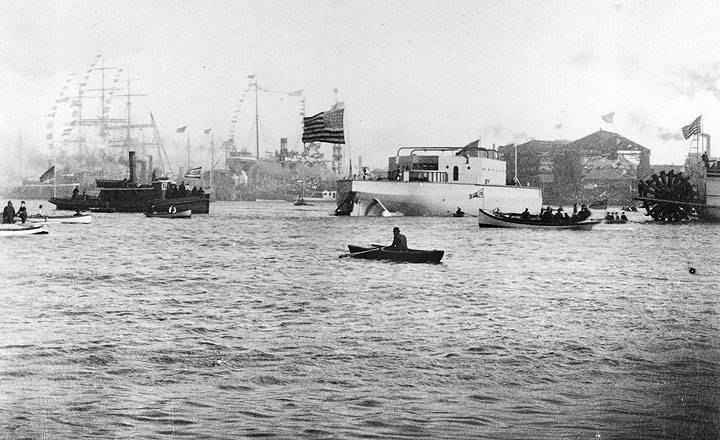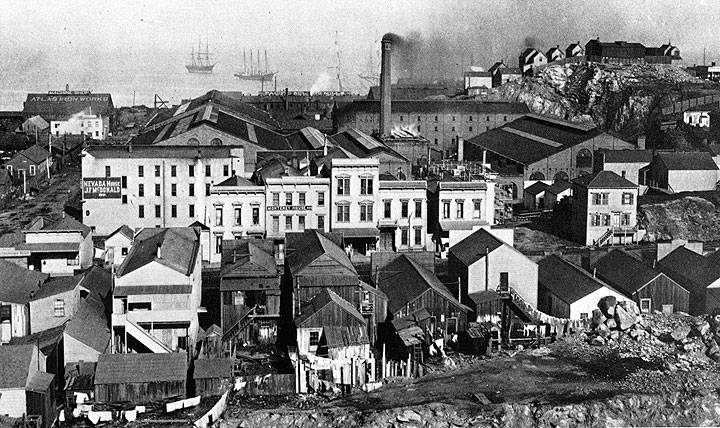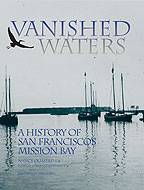Mission Bay Tidelands Controversy, 1868-1879
Historical Essay
by Nancy J. Olmsted
Mission Bay Railroad Land, 1870s. From the foot of Second Street, formerly Tichenor’s Ways, the right of way of the railroads and lands donated to the railroads by the state, as well as lands purchased by the railroads and land leased to the railroads, appear shaded on the map. The railroad right-of-way extended south over Hunters Point and included donated land in Islais Creek Basin. Also off this portion of the map, by reason of scale, are lands purchased by the railroad on the banks of Mission Creek. The map inset notes: “60 acres were donated, 58 acres were purchased, 4 were leased, for a total of 122 acres, plus 28 acres of tide lands donated for right of way for a total of 150 acres.” And further, “If the streets and the three Market Places lying within the 60 acre donation be granted to the R.R. Co. it will add about 42 acres to the above, making the Grand Total 192 acres or equivalent to 442 fifty-vara lots.”
Map: Potrero Hill Archives Project
The most important legislative act that determined the future of Mission Bay was California’s Tidelands Act of 1868. Various bills were introduced, amended, debated and commented upon in editorials headed: “Tidelands Conspiracy,” “Behemoth Tidelands Bill,” “Tidelands Grab.” From this historical distance it is impossible to know what kind of secret alliances were formed to push through various bills. The homestead associations were suspected of being front organizations for the railroads. Whereas initially the railroads could do no wrong, the monopolistic practices of the Central Pacific set up a strong counter-reaction that reached a fever pitch in San Francisco and put Governor Haight in office in 1867. Here was a governor who at least spoke against such methods, even though his own actions proved to have less integrity than his stated convictions.
Rumors and the Press
Since the thrust of various tidelands bills was to survey the tidelands of Mission Bay and Hunters Point and set aside railroad grants for rights-of-way, the San Francisco press assumed that the legislation was entirely aimed at giving the south waterfront to the Central Pacific. Among the typical stories is one picked up by the San Francisco Bulletin from the Sacramento Union, in early March 1868: “Those who are acquainted with the tendency of growth and business of San Francisco know that it is in the direction of the localities included in the proposed railroad grant. . . Real estate values are more rapidly increasing in the direction of Mission Bay and South San Francisco than anywhere else. . . It is hardly extravagant to expect that in less than ten years hence the heaviest shipping and wholesale business will be in the region of Long Bridge and Mission Bay. . . The property asked in this bill . . . includes the whole of Mission Bay and hundreds of acres further out than the mouth of the bay in the deep water of San Francisco Bay. . . . The whole grant asked to extend the waterline a mile and a half south of Hunters Point. . . . Central Pacific Railroad Company and their partners of the shadowy title would realize many millions, while the State would get perhaps $200,000. . . It would be an outrage to pass this bill. ”94
Early in March, 1868, a San Francisco Bulletin editorial appeared, entitled “The Tideland Conspiracy,” which said in part: “. . . all rival claimants. . . have united in support of the bill which proposes to give the railroad companies all the southern frontage of this city. The most prominent parties in this combination are the Central, Western, and Southern Pacific and San Jose Railroad Companies, whose interests are now identical; the South San Francisco Dock and Wharf Company, which already owns one or two miles of water frontage, which the Legislature is asked to extend to deep water; the association which holds certificates to 1,500 acres of land in Mission Bay. . . and finally Carpentier, who owns the Oakland frontage, with his railroad and real estate associates. These parties are all represented at Sacramento by influential men who have capital at command. . . further backed by a powerful professional lobby, embracing a number of notorious politicians and schemers.”95
The Tidelands Bill, as passed March 30, 1868
The daily revelations of the press, combined with the truly astonishing land grabs proposed in the various tidelands bills introduced in the legislature, served to modify the final product. The railroads wound up with 150 acres, mostly in Mission Bay, or the equivalent of 345.5 fifty-vara lots. With the streets and three market places included, another 42 acres were added for a grand total of 192 acres or 442 fifty-vara lots. However, these streets and three squares that were set aside as market places “reserved for public use” were specifically withheld from the grant. The accompanying 1869 map gives a clear idea of the lands involved.
Tidelands Auction Map, 1869. This portion of the official Board of Tideland Commissioners Map #3 shows some of the water lots to be auctioned in November 1869. The map is interesting because it shows a proposal to continue Channel Street’s canal to Seventh Street at a width of 140 feet, then to angle and narrow it to meet the mouth of Mission Creek at a width of 60 feet. The irregular line of salt marshes is the “Red Line of Mission Bay.” Inside the “Red Line” are water lots that were sold during the Peter Smith sales of 1853. The confusion over these various boundaries led to legal battles.
Map: David Rumsey Map Collection
The “Act to survey and dispose of certain salt marsh and tidelands belonging to the State of California” ordered the governor to appoint a Board of Tidelands Commissioners to “take possession of all the salt marsh and tidelands lying under water. . . belonging to the State of California. . . surveyed to a point not beyond twenty-four feet of water at the lowest stage of the tide. . . .” All such real property to be mapped and sold at public auction. Streets, docks and piers, canals and drains were reserved to the city of San Francisco.
The Southern Pacific and Western Pacific railroads were granted 30 acres each, exclusive of streets, basins and public squares, on land south of Channel Street and outside the redline waterfront of Mission Bay.96 In addition the railroads were given a right-of-way not to exceed 200 feet in width. In return the railroads had to agree to spend $100,000 within thirty months to construct a San Francisco terminus. After the time was extended in 1872, the Mission Bay railroad terminus was completed.
The Tideland Commissioners were to have the power to settle claimants’ disputes over water lots and to sell the tidelands as mapped and surveyed. All public monies were conveyed by the commissioners to the state. The three-man Tidelands Board appointed by Governor Haight was a powerful body, and it could be said to the commissioners’ credit that there was little criticism of their mode of operation, carried out as it was under the spotlight of every newspaper in San Francisco. They were to be involved in endless hearings of rival claims, sometimes stacked five deep on a single lot.
Trouble on Mission Creek: Squatters Riot
What was to prove one of the more troublesome sections of the 1868 Tidelands Act stated, “Where any settler was on the first day of January, A.D. 1868 in bona fide actual possession of any one lot by himself or tenant, and any additional lot in which he shall have had substantial improvements at the time aforesaid . . . may purchase such lot. . .” prior to public auctions, in effect, at private hearings before the Tidelands Commission.97 As can well be imagined, Mission Bay squatters (who preferred to be called “settlers”) interpreted the phrase “substantial improvements” as being fine-tuned to their own interests, since many of them were living in houses on the banks of Mission Creek and on filled portions of Mission Bay. “Bona fide actual possession” was seen as an endorsement of the principle of “squatters’ rights,” an idea long cherished in the Potrero and Mission Bay.
One cloud that hung over Mission Bay-Potrero lands was the long and exhausting legal efforts by Mexican claimants, in this case the de Haros, to clear their titles through the courts. In 1867 the de Haro claim to more than 2,000 acres near the Mission was rejected, as the courts ruled that the Mexican government had given the de Haros grazing rights but no clear title. On May 15, 1867 the Alta described the popular reaction: “At 7 o’clock a detachment of California Guard with two pieces crossed Long Bridge. . . they fired two hundred guns in honor of the settlers’ victory. There was another gun in the vicinity of North’s shipyard which also thundered forth a tremendous salute. . . . Early in the morning a mammoth bonfire was kindled on the highest point on Potrero Ridge . . . An impromptu meeting was held by the settlers. . . residents of the Potrero could breathe freely, now that this long contested controversy is settled. . .”
But having the major Mexican claim laid to rest by the Yankee courts gave all the more importance to the Tidelands Bill statement regarding “bona fide actual possession,” which was taken to mean “being there.” Rival claimants, some with titles going back to 1846, others to 1851 (with the sale of the Peter Smith water lots), moved into Mission Creek with pile drivers and a scow schooner armed with cannon (quickly dubbed the “Mission Creek Gunboat”); using pistols and knives they fought it out for possession.
On November 19, 1868, the Alta noted, “It will be remembered by our readers that within the past year Mr. Charles P. Duane shot Mr. Ross on Merchant Street for an alleged interference in this matter of title to lands. Yesterday morning, about 3 o’clock, several men made their appearance upon the ground and demanded possession. During the skirmish a man named Baxter was seriously wounded.” And again, a week later, “The trouble on Mission Creek continues . . . the police have charge of the pile driver, mud-scow, or ‘gunboat,’ and they have instructions to allow no one on board. . . if parties owning the gunboat make any attempt to move it, and if those who ran the pile-driver on disputed territory attempted to use it, riotous proceedings would follow.” Some sixty men fought it out on Mission Bay’s Block 40. Several were seriously wounded; that no one was killed was probably a matter of luck rather than restraint. Block 40 lay between Berry and Channel streets and Seventh and Eighth streets. The block as shown in 1869 is partially in the salt marsh and partially under the waters of Mission Bay.
By 1876 the State Senate had appointed the Mission Creek Investigating Committee to look into disputed tidelands decisions. In one such case, the commissioners gave Duane title to more than two and a half blocks of land “that should have been sold at public auction for the benefit of the state,” according to the San Francisco Bulletin on January 19, 1876. Duane, in fencing his tract, included his house on the upland that adjoins his tideland water lots. The Bulletin contended that the commissioners had no jurisdiction on the dry land portion of Duane’s land and the fence on the tidelands portion was not sufficient improvement. “Duane was not the only one who obtained valuable salt marsh and tidelands by virtue of a house built on high ground. How about Ellis himself? Let the investigation at Sacramento be thorough.”98
“The Ellis Land Grab Case” was fought in the 4th District Court in January 1877, as well as on the muddy banks of Mission Creek. Duane’s land and many more blocks were involved in a far more expansive scheme. Part of the problem stemmed from the lack of precise definition of the boundaries of the original San Francisco Pueblo Grant. Ellis found it useful to claim that the winding line of Mission Creek was the pueblo boundary and the Tidelands Commissioners had agreed, considering the overflow lands to be within their jurisdiction. Thus they gave Ellis clear title to land he claimed to have owned since 1853. Ellis now enlarged his claim to include “all land on either side of Mission Creek, from Nineteenth Street to Channel Street and including the overflow land adjacent to the creek, property valued at something like $4,000,000. There are several hundred claimants who are defendants in this section.”99
The Ellis claim was denied by the U.S. Circuit Court on July 29, 1878, when it rendered a decision that the pueblo lands of four square leagues (granted to Yerba Buena and confirmed to San Francisco on May 18, 1865) included the swamp land, “that is, the eastern boundary of the city follows the line of the ordinary high water, crossing the mouths of streams, and not following their banks. ”100
In another case, Tripp vs. Spring, Judge Field made a statement that had far-reaching consequences to the property holders in Mission Bay and the Potrero, when some twenty-two entire blocks were under disputed title: “Mission Creek never constituted any portion of the Bay of San Francisco any more than the Sacramento River constitutes a portion of the Bay of Suisun, or the Hudson River a portion of the Bay of New York. . . The boundary of the tract [confirmed to the city as part of the Pueblo] runs along the Bay on the line of ordinary high water mark, as that existed in 1846, crossing the mouth of creeks running into the Bay, and that of Mission Creek, among others. The boundary would have been a singular one had it followed the windings of that creek and its branches, wherever the tide-waters of the Bay may have flowed.”101
Judge Field’s opinion had the further salutory effect of giving the settlers in the Potrero and Mission Bay what they had wanted, peace from further challenges of any real importance to their presence.
What the Tidelands Commissioners Disposed of from 1868 to 1872
In carrying out the vast tidelands survey as ordered by the 1868 legislative act, the commissioners reported that 65,200 acres were surveyed, of which 13,200 were judged to be covered by state patents and legislative grants and therefore were not subject to sale. Of the remaining acres, 33,200 were reserved for canals and other aids to commerce and 14,400 were sold, as instructed, leaving only 4,400 surveyed acres unsold. The balance included the land between Black Point and Fort Point in San Francisco.102
Already concern was being expressed about filling-in the great bay of San Francisco, as evidenced by a letter to the Chronicle dated January 30, 1874: “In the course of an interview with Col. Mendell, U.S. Engineer, that gentleman showed me a map of the Bay of San Francisco which indicated that the State had parted with her title to the tidelands to an extent that there was absolutely nothing left to save. . . the water area in San Francisco Bay is in round figures 400 square miles, while the land covered by water has passed into private ownership to the extent of more than 300 square miles. If it were lawful to fill in all this submerged land, the harbor of San Francisco would be utterly destroyed.”
In 1872, “Save the Bay!” had not yet been sounded—it would be another 100 years before reality set in and the importance of retaining salt marshes and wetlands reversed the seemingly immutable conception of “development seen as progress.”
Filling In Mission Bay. . . 1889
The Coast Survey Map of 1889 demonstrates how Long Bridge became the focal point for filling in Mission Bay. Jutting out the line of Fourth Street, carrying the railroad lines to the Southern Pacific freight sheds between Townsend and King streets, Long Bridge by then had a man-made delta at Third Street.
1889 U.S. Coastal Survey Map.
Map courtesy Christopher Richard, Oakland Museum of California
The “busiest part of the port” in the late 1880s and ’90s centered around Channel Street, with its finger piers reaching out to the scows and schooners bringing in bricks and cement, shingles and spars, lumber to be milled on Berry Street, grain for the South End Warehouse and hay for the horses that kept the city moving. Just north of the Channel Street entrance to the bay, steamers of the Pacific Mail Steamship Company arrived from New York and the Far East. At the foot of Second Street, Tichenor’s Ways has been sold to the Southern Pacific for $250,000 and is now the pier where the big railroad ferryboat, the Thoroughfare, brings locomotives and freight cars to run along the King Street rails to the Southern Pacific freight yards.
The north side of Channel Street is very nearly filled in from Third to Sixth, where the map shows a slender finger of fill reaching south to connect with the line of Sixteenth Street, near the Point of Rocks. South of Berry, between Sixth and Seventh streets, an informal garbage dump persisted from 1878 until 1895, gradually extending until it covered twenty acres south of the channel. Garbage from the densely populated south-of-Market district came here at the rate of three hundred wagons a day. Before it was shoveled into the bay water, the “dump trust” sorted through everything for salvage.
Largest of three small peaks on a submerged ridge, Mission Rock rose twenty-five feet above the bay waters and served as a navigational guide for ships. By 1884 it was more useful as an extended wharf to hold warehouses, as seen in the inset drawing made in 1900. H.B. Tichenor had his eye on Mission Rock when he sold out his marine railway to the railroad interests in 1870. He secured a tidelands’ grant to some submerged land around the rock and built a drydock, expanding less than a fourth of an acre into four acres.
Image: Bancroft Library
“With a general air of dejected doggedness, many were busily engaged with pitchfork, shovel or stick, sifting each load as it was dumped from the reeking, overflowing carts. Rags, old bottles, scraps of iron, old sacks, bricks, oyster shells, half-decayed fruit and vegetables—all were prized.103 Although the police sporadically raided “Dumpville,” burning the shacks that were put on “railroad lands,” the scavengers returned and business continued, since there were no neighbors to complain. The degree of pollution at Channel Street and in Mission Bay became so great that the water was sickening to smell and deadly to fall into.
On the 1889 Coast Survey Map, all that remains from Mission Creek’s original estuary (as shown in 1852) is an inlet that hooks around toward Brannan and Eighth streets. By 1874, Mission Creek above Ninth and Brannan had been officially abandoned as a navigable stream.104 All of the land east of Mission Creek’s tidal remnant (south of Brannan and east to Fourth Street) had been progressively created by filling or spanning the waters of Mission Bay. The salt marsh at the southwestern edge of Mission Bay is more fenced than filled; only a few isolated farms appear on the 1889 chart.
Potrero Point
In contrast to the nearly empty edge of the old salt marsh is the industrial buildup at Potrero Point. Here the dream of the 1860s is realized by 1884. The Union Iron Works opened in 1882, directly adjoining the Pacific Rolling Mills, the point’s first major manufacturing industry, dating back to 1866. The Western Sugar Refinery dominated the southern waterfront of Potrero Point. Within a few years, the Atlas Iron Works would locate here.
In spite of the depression, the big mills reverberated day and night, producing mining machinery, pumps, boilers, iron for the railroads, streetcar rails, bridges, marine hardware and big walking-beam engines, iron-clad monitors and cruisers for the Navy. Potrero production was the center of San Francisco’s industrial output from 1884 through the first World War.
(Above) Launch of the USS Monterey from the Union Iron Works, April 28, 1891.
Photo: San Francisco Maritime National Historical Museum (A4.28,556)
San Francisco paid higher wages to skilled craftsmen and industrial workers than could be earned in the East. But jobs were scarce and fought over. Poverty in the city was grinding and seemed never to end, bringing ugly outbreaks of anti-Chinese feeling as both races scrambled for any available work.
The men who worked on Potrero Point lived there as well. Bill Carr, sheriff’s deputy in South San Francisco for forty-six years, came to Irish Hill as an infant in 1877 and grew up in the streets seen in the view below. The accompanying caption is his recollection.
“It was mostly all hotels. . . The Green House, run by Mike Farrell. The White House run by Hans Rasmussen. Cash’s Hotel, run by Jimmy Cole. The San Quentin House run by Jim Gately. Gately took in the parolees from San Quentin and got them jobs in the rollin’ mills. . . There was Paddy Kearns’ Hotel, and outside the gashouse was Miek Boyle’s steam beer dump. . . The boys from one hotel would challenge the boys from another and fight all Saturday afternoon in a hayrope ring outside Gately’s Hotel. Then we’d all go in and knock off steam beers for a nickel a piece . . . You went up on Irish Hill when you got off work and you never left it until morning. Below it was Dutchman’s Flat, where the Dutchmen from the old country lived. . . Eight or nine hundred people use to live there. . . There were 98 wooden steps up the hill.”105 This view, taken in the 1890s, shows what was left of the serpentine hill, much of it having been blasted away and dumped in the bay.
Photo: Bancroft Library
This is chapter eleven of "Vanished Waters: A History of San Francisco's Mission Bay" published by the Mission Creek Conservancy, and republished here with their permission.
NOTES
94. Bancroft Scraps, Bulletin, reprinted from Sacramento Union, March, 1868.
95. Ibid. Bulletin March 3, 1868.
96. The “Eddy Redline” that appears on various maps of the tideland surveys refers to William Eddy, whose 1849-1850 survey was the first since Jasper O’Farrell’s 1847 efforts. In October of 1849 the town council ordered William Eddy to extend O’Farrell’s survey, as all the lots had been sold within the old city limits. The Eddy Redline delineates additional lands as far west of the old boundaries as Leavenworth and Eighth streets, near the present Civic Center. By January 1850 more than 3,000 of these lots had been sold.
97. California Statutes, March 30, 1868, p.720.
98. In another article on January 10, 1876, the Bulletin noted, “Captain John North and Captain Henry Owens had a few sessions earlier applied for 25 year franchises to use the ‘mud’ and waters ebbing and flowing over it for a considerable distance from the mainland. It was thought proper that shipbuilders of this city should also be entitled to favorable consideration. But these men did not take advantage of the Tidelands Act... This exemption [North’s and Owen’s marine railways] created some dissatisfaction among the fence builders. . .”
99. San Francisco Bulletin, January 23, 1877.
100. Alta California, August 31, 1878.
101. Alta California, August 19, 1878.
102. Alta California, January 7, 1872. The same article notes, “The total sales [tideland properties] amounted to $1.477,929.92. With expenses, the State of California netted $1,242,495.92. The University of California was given $200,000 from the sales and a perpetual annuity, according to an amendment of the original Tidelands Act.
103. San Francisco, Daily Evening Post, August 1878, and Chronicle, November 22, 1889.
104. Sharpsteen, “Vanished Waters of Southeastern San Francisco,” p. 115.

